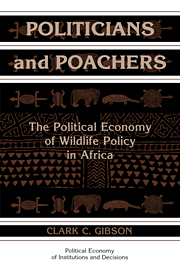Book contents
- Frontmatter
- Contents
- Series editor's preface
- Acknowledgments
- 1 Politics, Institutions, and Animals: Explaining the Content, Continuity, and Change of African Wildlife Policy
- I The National Politics of Wildlife Policy
- II The Bureaucratic Politics of Wildlife Policy
- III The Local Politics of Wildlife Policy
- 5 The Consequences of Institutional Design: The Impact of “Community-Based” Wildlife Management Programs at the Local Level
- 6 Conclusion: Exploring the Political Economy of African Wildlife Policy
- Notes
- Bibliography
- Index
5 - The Consequences of Institutional Design: The Impact of “Community-Based” Wildlife Management Programs at the Local Level
Published online by Cambridge University Press: 02 December 2009
- Frontmatter
- Contents
- Series editor's preface
- Acknowledgments
- 1 Politics, Institutions, and Animals: Explaining the Content, Continuity, and Change of African Wildlife Policy
- I The National Politics of Wildlife Policy
- II The Bureaucratic Politics of Wildlife Policy
- III The Local Politics of Wildlife Policy
- 5 The Consequences of Institutional Design: The Impact of “Community-Based” Wildlife Management Programs at the Local Level
- 6 Conclusion: Exploring the Political Economy of African Wildlife Policy
- Notes
- Bibliography
- Index
Summary
We want local people to protect the animals. [Laughter in the National Assembly's chambers.]
The Honorable R. A. Natala, addressing the National Assembly, 13 August 1982A growing number of conservationists and development specialists in the 1970s and 1980s, including the administrators of ADMADE and LIRDP, argued that the inclusion of local communities in wildlife management was indispensable for successful conservation. These experts charged that because conventional policies excluded rural residents from the economic benefits of wildlife, they had no incentive to stop illegal hunting. And because the wildlife departments of many African governments were woefully underfunded, locals killed animals with impunity.
To close what had become an open-access wildlife commons in Zambia, ADMADE and LIRDP each offered an array of benefits designed to encourage locals to protect rather than hunt animals. A number of rural residents gained employment as wildlife scouts and general laborers. Certain traditional leaders received control over the revenue that the programs apportioned to local communities. ADMADE and LIRDP revenue built schools, health clinics, roads, bridges, and other communitylevel projects. And both programs intended to foster cooperation between scouts and residents.
Yet, even with ADMADE and LIRDP in place, rural residents continued to kill, consume, and trade wild animals illegally. Although wildlife scouts made more arrests for poaching-related activities, and although both programs seemed to stem the killing of large mammals, locals kept hunting - at rates comparable to those of the days before ADMADE and LIRDP's operations.
- Type
- Chapter
- Information
- Politicians and PoachersThe Political Economy of Wildlife Policy in Africa, pp. 119 - 152Publisher: Cambridge University PressPrint publication year: 1999
- 1
- Cited by



